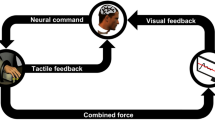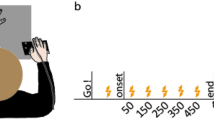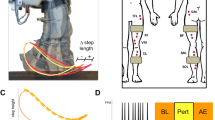Abstract
Here we have identified a sensorimotor transformation that is used by a mammalian nervous system to produce a multijoint motor behavior. Using a simple biomechanical model, a delayed-feedback rule based on an optimal tradeoff between postural error and neural effort explained patterns of muscle activation in response to a sudden loss of balance in cats. Following the loss of large sensory afferents, changes in these muscle-activation patterns reflected an optimal reweighting of sensory feedback gains to minimize postural instability. Specifically, a loss of center-of-mass-acceleration information, which allowed for a rapid initial rise in the muscle activity in intact animals, was absent after large-fiber sensory neuropathy. Our results demonstrate that a simple and flexible neural feedback control strategy coordinates multiple muscles over time via a small set of extrinsic, task-level variables during complex multijoint natural movements.
This is a preview of subscription content, access via your institution
Access options
Subscribe to this journal
Receive 12 print issues and online access
$209.00 per year
only $17.42 per issue
Buy this article
- Purchase on Springer Link
- Instant access to full article PDF
Prices may be subject to local taxes which are calculated during checkout






Similar content being viewed by others
References
Tresch, M.C., Saltiel, P. & Bizzi, E. The construction of movement by the spinal cord. Nat. Neurosci. 2, 162–167 (1999).
Ting, L.H. & Macpherson, J.M. A limited set of muscle synergies for force control during a postural task. J. Neurophysiol. 93, 609–613 (2005).
d'Avella, A. & Bizzi, E. Shared and specific muscle synergies in natural motor behaviors. Proc. Natl. Acad. Sci. USA 102, 3076–3081 (2005).
Flash, T. & Hochner, B. Motor primitives in vertebrates and invertebrates. Curr. Opin. Neurobiol. 15, 660–666 (2005).
Ting, L.H. Dimensional reduction in sensorimotor systems: a framework for understanding muscle coordination of posture. in Computational Neuroscience: Theoretical Insights into Brain Function, Progress in Brain Research 165 (eds. Cisek, P., Drew, T. & Kalaska, J.F.) 301–325 (Elsevier, Amsterdam, 2007).
Cappellini, G., Ivanenko, Y.P., Poppele, R.E. & Lacquaniti, F. Motor patterns in human walking and running. J. Neurophysiol. 95, 3426–3437 (2006).
d'Avella, A., Saltiel, P. & Bizzi, E. Combinations of muscle synergies in the construction of a natural motor behavior. Nat. Neurosci. 6, 300–308 (2003).
Poppele, R. & Bosco, G. Sophisticated spinal contributions to motor control. Trends Neurosci. 26, 269–276 (2003).
Ting, L.H. & Macpherson, J.M. Ratio of shear to load ground-reaction force may underlie the directional tuning of the automatic postural response to rotation and translation. J. Neurophysiol. 92, 808–823 (2004).
Horak, F.B. & Macpherson, J.M. Postural orientation and equilibrium. in Handbook of Physiology, Section 12, 255–92 (American Physiological Society, New York, 1996).
Gollhofer, A., Horstmann, G.A., Berger, W. & Dietz, V. Compensation of translational and rotational perturbations in human posture: stabilization of the centre of gravity. Neurosci. Lett. 105, 73–78 (1989).
Todorov, E. Direct cortical control of muscle activation in voluntary arm movements: a model. Nat. Neurosci. 3, 391–398 (2000).
Graziano, M. The organization of behavioral repertoire in motor cortex. Annu. Rev. Neurosci. 29, 105–134 (2006).
Scott, S.H. Optimal feedback control and the neural basis of volitional motor control. Nat. Rev. Neurosci. 5, 532–546 (2004).
Todorov, E., Li, W. & Pan, X. From task parameters to motor synergies: a hierarchical framework for approximately optimal control of redundant manipulators. J. Robot Syst. 22, 691–710 (2005).
Loeb, G.E., Brown, I.E. & Cheng, E.J. A hierarchical foundation for models of sensorimotor control. Exp. Brain Res. 126, 1–18 (1999).
Stapley, P.J., Ting, L.H., Hulliger, M. & Macpherson, J.M. Automatic postural responses are delayed by pyridoxine-induced somatosensory loss. J. Neurosci. 22, 5803–5807 (2002).
Macpherson, J.M. Strategies that simplify the control of quadrupedal stance. II. Electromyographic activity. J. Neurophysiol. 60, 218–231 (1988).
Diener, H.C., Horak, F.B. & Nashner, L.M. Influence of stimulus parameters on human postural responses. J. Neurophysiol. 59, 1888–1905 (1988).
Bosco, G., Poppele, R.E. & Eian, J. Reference frames for spinal proprioception: limb endpoint based or joint-level based? J. Neurophysiol. 83, 2931–2945 (2000).
Nashner, L.M. Adapting reflexes controlling the human posture. Exp. Brain Res. 26, 59–72 (1976).
Risher, D.W., Schutte, L.M. & Runge, C.F. The use of inverse dynamics solutions in direct dynamics simulations. J. Biomech. Eng. 119, 417–422 (1997).
Torres-Oviedo, G., Macpherson, J.M. & Ting, L.H. Muscle synergy organization is robust across a variety of postural perturbations. J. Neurophysiol. 96, 1530–1546 (2006).
Torres-Oviedo, G. & Ting, L.H. Muscle synergies characterizing human postural responses. J. Neurophysiol. published online 25 July 2007 (doi:10.1152/jn.01360.2006).
Alexandrov, A.V., Frolov, A.A. & Massion, J. Biomechanical analysis of movement strategies in human forward trunk bending. I. Modeling. Biol. Cybern. 84, 425–434 (2001).
van Antwerp, K.W., Burkholder, T.J. & Ting, L.H. Interjoint coupling effects on muscle contributions to endpoint force and acceleration in a musculoskeletal model of the cat hindlimb. J. Biomech. published online 17 July 2007(doi:10.1016/j.jbiomech.2007.06.001).
He, J.P., Levine, W.S. & Loeb, G.E. Feedback gains for correcting small perturbations to standing posture. Proceedings of the 28th IEEE Conference on Decision and Control, 1989. 1, 518–526 (1991).
Jo, S. & Massaquoi, S.G. A model of cerebellum stabilized and scheduled hybrid long-loop control of upright balance. Biol. Cybern. 91, 188–202 (2004).
Kuo, A.D. An optimal state estimation model of sensory integration in human postural balance. J. Neural Eng. 2, S235–S249 (2005).
Peterka, R.J. Sensorimotor integration in human postural control. J. Neurophysiol. 88, 1097–1118 (2002).
Inglis, J.T., Horak, F.B., Shupert, C.L. & Jones-Rycewicz, C. The importance of somatosensory information in triggering and scaling automatic postural responses in humans. Exp. Brain Res. 101, 159–164 (1994).
Inglis, J.T. & Macpherson, J.M. Bilateral labyrinthectomy in the cat: effects on the postural response to translation. J. Neurophysiol. 73, 1181–1191 (1995).
Runge, C.F., Shupert, C.L., Horak, F.B. & Zajac, F.E. Role of vestibular information in initiation of rapid postural responses. Exp. Brain Res. 122, 403–412 (1998).
Georgopoulos, A.P., Schwartz, A.B. & Kettner, R.E. Neuronal population coding of movement direction. Science 233, 1416–1419 (1986).
Deliagina, T.G., Zelenin, P.V., Beloozerova, I.N. & Orlovsky, G.N. Nervous mechanisms controlling body posture. Physiol. Behav. published online 21 May 2007 (doi:10.1016/j.physbeh.2007.05.023).
Macpherson, J.M. & Fung, J. Weight support and balance during perturbed stance in the chronic spinal cat. J. Neurophysiol. 82, 3066–3081 (1999).
Hyngstrom, A.S., Johnson, M.D., Miller, J.F. & Heckman, C.J. Intrinsic electrical properties of spinal motoneurons vary with joint angle. Nat. Neurosci. 10, 363–369 (2007).
Lin, D.C. & Rymer, W.Z. Damping actions of the neuromuscular system with inertial loads: soleus muscle of the decerebrate cat. J. Neurophysiol. 83, 652–658 (2000).
Todorov, E. Optimality principles in sensorimotor control. Nat. Neurosci. 7, 907–915 (2004).
Nashner, L.M. Fixed patterns of rapid postural responses among leg muscles during stance. Exp. Brain Res. 30, 13–24 (1977).
Macpherson, J.M., Everaert, D.G., Stapley, P.J. & Ting, L.H. Bilateral vestibular loss in cats leads to active destabilization of balance during pitch and roll rotations of the support surface. J. Neurophysiol. 97, 4357–4367 (2007).
Macpherson, J.M. The force constraint strategy for stance is independent of prior experience. Exp. Brain Res. 101, 397–405 (1994).
Schafer, S.S. The acceleration response of a primary muscle-spindle ending to ramp stretch of the extrafusal muscle. Experientia 23, 1026–1027 (1967).
Boyd, I.A. The histological structure of the receptors in the knee joint of the cat correlated with their physiologic response. J. Physiol. (Lond.) 124, 476–488 (1954).
Johansson, R.S., Riso, R., Hager, C. & Backstrom, L. Somatosensory control of precision grip during unpredictable pulling loads. I. Changes in load force amplitude. Exp. Brain Res. 89, 181–191 (1992).
Jeka, J., Kiemel, T., Creath, R., Horak, F.B. & Peterka, R.J. Controlling human upright posture: velocity information is more accurate than position or acceleration. J. Neurophysiol. 92, 2368–2379 (2004).
Poggio, T. & Bizzi, E. Generalization in vision and motor control. Nature 431, 768–774 (2004).
Chhabra, M. & Jacobs, R.A. Properties of synergies arising from a theory of optimal motor behavior. Neural Comput. 18, 2320–2342 (2006).
Soechting, J.F. & Lacquaniti, F. Quantitative evaluation of the electromyographic responses to multidirectional load perturbations of the human arm. J. Neurophysiol. 59, 1296–1313 (1988).
van der Kooij, H., Jacobs, R., Koopman, B. & Grootenboer, H. A multisensory integration model of human stance control. Biol. Cybern. 80, 299–308 (1999).
Acknowledgements
We thank J.M. Macpherson and P.J. Stapley for use of the data and helpful comments, R.J. Peterka for his technical guidance, A. Koenig for help with the simulations, and J.L. McKay for his insightful editorial assistance. This work was supported by Whitaker Grant RG–02–0747.
Author information
Authors and Affiliations
Contributions
D.B.L. developed and validated the TSyID and DQR formulations, performed the simulations and data analysis and contributed to writing the manuscript. L.H.T. conceptualized the model, developed the dual-ramp perturbations, participated in experiments, supervised the research and wrote the manuscript.
Corresponding author
Rights and permissions
About this article
Cite this article
Lockhart, D., Ting, L. Optimal sensorimotor transformations for balance. Nat Neurosci 10, 1329–1336 (2007). https://doi.org/10.1038/nn1986
Received:
Accepted:
Published:
Issue Date:
DOI: https://doi.org/10.1038/nn1986
This article is cited by
-
Assisting walking balance using a bio-inspired exoskeleton controller
Journal of NeuroEngineering and Rehabilitation (2023)
-
Neuromuscular organisation and robustness of postural control in the presence of perturbations
Scientific Reports (2019)
-
Deciphering the functional role of spatial and temporal muscle synergies in whole-body movements
Scientific Reports (2018)
-
Low-dimensional organization of angular momentum during walking on a narrow beam
Scientific Reports (2018)
-
Optimal feedback control to describe multiple representations of primary motor cortex neurons
Journal of Computational Neuroscience (2017)



